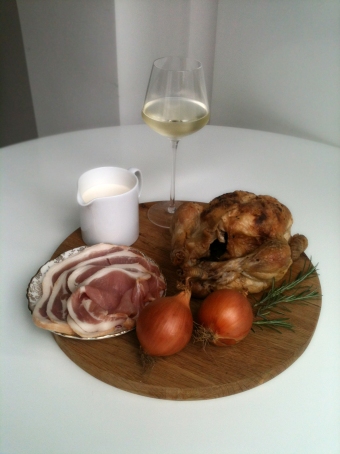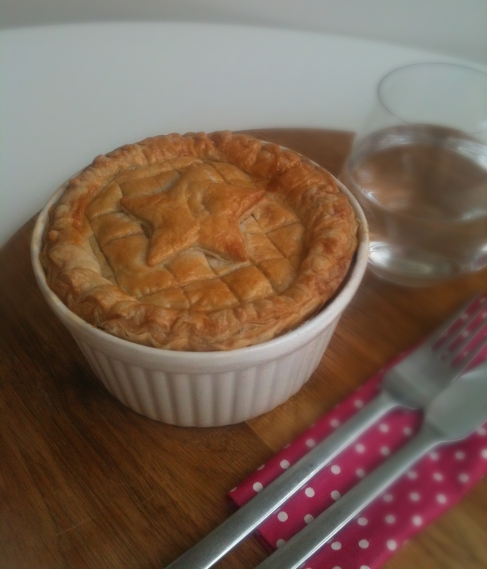Unless you’ve been locked away for the past few months, you will know it’s the Queens Diamond Jubilee over the next week. So, I’ve decided to jump on the band wagon with a Jubilee recipe.
Perhaps because I’m originally from Ireland, I didn’t come across the original base of this recipe until I moved to live in England nearly 10 years ago. However, it’s been a firm sandwich filler favourite ever since.
Originally concocted for the banquet to celebrate the Queens coronation in 1953, I have created my own modern version with…
Coronation Chicken Pizza.
It’s only recently that I discovered how easy pizza is to make. I will admit, I’ve always been reluctant to attempt any recipes with yeast in. When I was younger I didn’t have much patience for sitting around waiting for things to rise but now that I am older (and a little bit more boring perhaps) I’m actually quite interested in science of it all. The fact that yeast is a living thing amazes me but the magic of a small ball of dough doubling into a billowing pillow by itself is fascinating. Geekery aside though I challenge you to find something better than a good pizza, crunchy salad and cold bottled beer outside on a summers day!
The recipe is actually more of a deconstructed coronation chicken but does contain most of the same ingredients as the original recipe by Rosemary Hume in 1953. It makes 4 large pizzas, so great for a small jubilee party. Luckily, if you only want to make one, all the ingredients are freezable, including the pizza dough.
Like with my Creamy Chicken and Bacon Pie, left over Sunday roast chicken can be used. For now though, I have followed the original 1953 method of poaching a chicken with my own choice of flavourings.
For the poached chicken you will need:
- Whole Chicken 1.5kg
- 1 cinnamon stick
- 5 black peppercorns
- 1 tsp salt
- 1 bay leaf
- 1.5 cm fresh ginger
Put the chicken in a large pan and fill will cold water leaving the top of the breasts out of the water. Add the cinnamon stick, peppercorns, salt, bay leaf and ginger and cover the pan. On a medium heat bring to a simmer and then reduce right down and leave to cook for 1hr 30mins.
While the chicken is cooking make the pizza dough.
For the Pizza dough you will need:
- 325ml Luke warm water
- 1/2 tbsp Golden caster sugar
- 2 tbsp extra virgin Olive oil
- 7g sachet of fast acting yeast
- 1/2 tbsp Salt
- 500g Strong white bread flour
- 2 tbsp semolina or polenta (for later)
In a measuring jug mix the water, sugar, oil and yeast together and leave for 5 mins. In that time, sieve the flour and salt together onto a clean and dry work surface, then make a large well in the centre. Dust a large bowl with extra flour.
Slowly pour the liquid in the well and using a fork gradually stir in the flour from around the well. Once combined, flour your hands and kneed the dough for few minutes. When you think the dough is formed (it will still be sticky) put into the floured bowl adding another dusting to cover the top of the dough. Cover with a damp tea towel and leave to rise in a warm place for 1 hour. (Near the cooking chicken is good but if you are preparing in advance you can leave it on a chair in front of a warm oven).
After an hour your dough will have doubled in size! Turn this out onto a floured surface and then kneed again for a few more minutes and then its ready to be used. For now though, separate into 4 equal balls, cover with cling film and place in the refrigerator (you can also freeze the dough at this stage).
*If putting in the fridge then make sure to take it out leave at room temperature for at least 15 mins before you want to to cook your pizza.
Your chicken should be done by now too. Take this out of the pan and check that the juices are running clear. Leave to rest and cool on a chopping board.
Once cooled enough to handle break up the chicken into chunks and leave on a plate to cool completely.
For the sauce and marinade you will need:
- 1tbsp sunflower oil
- 1/2 medium sized onion finely chopped
- 1 tbsp Mild curry powder
- 1.5cm chunk of fresh ginger peeled and roughly chopped
- 2 tbsp tomato purée
- 50ml red wine
- 50ml water
- 2 tsp Worcestershire sauce
- 2 slices of lemon
- 2 tsp lemon juice
- 1 bay leaf
- 5 tbsp mango chutney
- 400g tin/cartoon chopped tomatoes
- 1 tbsp golden caster sugar
Heat the oil in a flat based pan and add the finely chopped onions. Fry for 3/4mins and then add the ginger and curry powder and fry for a further 2 minutes.
Next add the tomato purée, wine, water, Worcester sauce,1 bay leaf, two slices of lemon, lemon juice and salt and pepper. Bring to the boil and then simmer for 10mins.
Take off the heat, let it cool a little and then add the mango chutney and stir thoroughly.
Now remove around half the mixture from the pan and set aside to cool. This will be the paste to marinade the chicken.
Add the chopped tomatoes to the rest of the mixture in the pan along with the sugar. Bring to the boil again then reduce and simmer for 15 mins stirring occasionally. Let to cool slightly before putting the mixture through a sieve into a clean bowl. We now have a smooth sauce for the base of our pizza.
For the toppings of each INDIVIDUAL pizza you will need:
- 30 g mature chedder cheese grated (or similar)
- 1/2 red onion finely sliced
- 30 g almonds
- Pinch of ground black pepper
- 30 g sultanas
- 4 tbsp creme fraiche
Preheat your oven to as hot as it will go and insert the tray you will be cooking your pizza on.
*Tip – if using a baking tray turn it upside down so you can easily slide the pizza off later.
Take your marinade from earlier and extract 2 tbsp from it and set aside. In a clean bowl take your chunks of chicken and coat this with the remaining marinade.
Soak the sultanas in some boiling water for 5 minutes to make them moist.
Sprinkle a clean work surface with 2 tbsp of semolina/polenta and a large dusting on flour. Roll out your pizza dough so that it is about £1 size deep. You can use a floured rolling pin or you hands.
Take the tray out of the oven and reduce the temperature to around 180C
Transfer you dough onto your tray. Spread the tomato base evenly over the pizza, along with the marinated chicken, red onion, cheese and 1/2 the sultanas. Cook in the oven for 8-10mins.
While it cooks…
In a clean bowl mix two tbsp of the marinade with 4 tbsp of creme fraiche. Roughly chop the remaining half of the sultanas and stir into the creamy mixture. Set to one side.
Toast the almonds in a dry flat pan on a medium heat for 3 mins and remove immediately onto some kitchen paper and set aside.
Remove the pizza from the oven and scatter the toasted almonds and creamy sauce over the pizza and garnish with some coriander.
Serve with any leftover creamy sauce and toasted almonds and ENJOY!


































